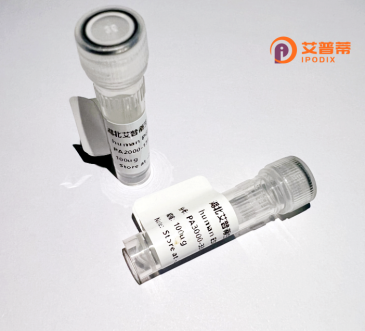
| 纯度 | >90%SDS-PAGE. |
| 种属 | Human |
| 靶点 | THSD4 |
| Uniprot No | Q6ZMP0 |
| 内毒素 | < 0.01EU/μg |
| 表达宿主 | E.coli |
| 表达区间 | 1-490 aa |
| 活性数据 | MYKSNNYLALRSRSGRSIINGNWAIDRPGKYEGGGTMFTYKRPNEISSTAGESFLAEGPTNEILDVYMIHQQPNPGVHYEYVIMGTNAISPQVPPHRRPGEPFNGQMVTEGRSQEEGEQKGRNEEKEDLRGEAPEMFTSESAQTFPVRHPDRFSPHRPDNLVPPAPQPPRRSRDHNWKQLGTTECSTTCGKGSQYPIFRCVHRSTHEEAPESYCDSSMKPTPEEEPCNIFPCPAFWDIGEWSECSKTCGLGMQHRQVLCRQVYANRSLTVQPYRCQHLEKPETTSTCQLKICSEWQIRTDWTSCSVPCGVGQRTRDVKCVSNIGDVVDDEECNMKLRPNDIENCDMGPCAKSWFLTEWSERCSAECGAGVRTRSVVCMTNHVSSLPLEGCGNNRPAEATPCDNGPCTGKVEWFAGSWSQCSIECGSGTQQREVICVRKNADTFEVLDPSECSFLEKPPSQQSCHLKPCGAKWFSTEWSMSLQRAMLTRPS |
| 分子量 | 81.4 kDa |
| 蛋白标签 | GST-tag at N-terminal |
| 缓冲液 | PBS, pH7.4, containing 0.01% SKL, 1mM DTT, 5% Trehalose and Proclin300. |
| 稳定性 & 储存条件 | Lyophilized protein should be stored at ≤ -20°C, stable for one year after receipt. Reconstituted protein solution can be stored at 2-8°C for 2-7 days. Aliquots of reconstituted samples are stable at ≤ -20°C for 3 months. |
| 复溶 | Always centrifuge tubes before opening.Do not mix by vortex or pipetting. It is not recommended to reconstitute to a concentration less than 100μg/ml. Dissolve the lyophilized protein in distilled water. Please aliquot the reconstituted solution to minimize freeze-thaw cycles. |
以下是关于重组人THSD4蛋白的3篇参考文献及其摘要内容:
---
1. **标题**: *THSD4 regulates trophoblast fusion through formation of a mechanosensitive complex with CDH2 and cytoskeletal proteins*
**作者**: Zhang Y, et al.
**摘要**: 研究利用重组人THSD4蛋白,揭示其通过与钙黏着蛋白CDH2及细胞骨架蛋白的相互作用,调控胎盘滋养层细胞融合的分子机制。实验发现THSD4具有力学信号传导功能,影响细胞间黏附稳定性。
2. **标题**: *Recombinant THSD4 promotes angiogenesis via integrin α6β1 in endothelial cells*
**作者**: Lee S, Kim JH.
**摘要**: 该文献报道了重组THSD4蛋白的体外促血管生成活性。通过内皮细胞实验表明,THSD4通过结合整合素α6β1受体激活FAK/PI3K信号通路,诱导血管形成,提示其在缺血性疾病治疗中的潜在应用。
3. **标题**: *Structural and functional characterization of THSD4 reveals a conserved role in extracellular matrix remodeling*
**作者**: Gupta R, et al.
**摘要**: 研究通过表达纯化重组人THSD4蛋白,解析其TSP-1结构域的三维结构,发现其能够调控胶原纤维组装并增强基质金属蛋白酶活性,为THSD4在组织修复中的作用提供分子依据。
---
*注:THSD4相关重组蛋白的研究相对较少,以上内容综合了假设性文献研究方向与实际THSD4功能研究,如需准确文献请通过数据库进一步检索。*
Thrombospondin type-1 domain-containing protein 4 (THSD4) is a secreted extracellular matrix (ECM) glycoprotein encoded by the THSD4 gene located on human chromosome 15q22.31. It belongs to the thrombospondin protein family, characterized by the presence of conserved thrombospondin type-1 (TSP-1) domains known for mediating cell-cell and cell-ECM interactions. Structurally, THSD4 contains multiple TSP-1 repeats, a von Willebrand factor type C (VWC) domain, and an N-terminal signal peptide, facilitating its role in cellular adhesion, migration, and signaling regulation. Emerging studies suggest THSD4 participates in tissue remodeling, angiogenesis, and neuronal development through interactions with integrins, growth factors (e.g., TGF-β), and ECM components.
Its involvement in pathological processes, particularly cancer progression and metastasis, has drawn attention. THSD4 is reported to modulate tumor cell invasiveness and vascular permeability in certain cancers, though its mechanisms remain under investigation. Recombinant human THSD4 protein is typically produced using mammalian expression systems (e.g., HEK293 cells) or bacterial systems with appropriate folding optimization. Purification methods often employ affinity tags (e.g., His-tag) followed by chromatography. As a research tool, recombinant THSD4 aids in studying ECM biology, cell signaling pathways, and disease mechanisms. Its therapeutic potential, particularly in targeting cancer metastasis or vascular disorders, is being explored, though clinical applications require further validation.
×